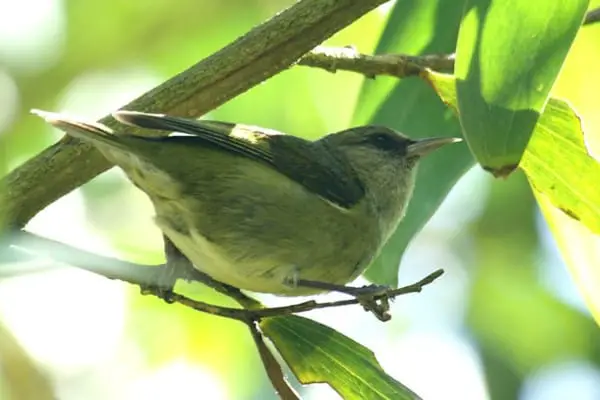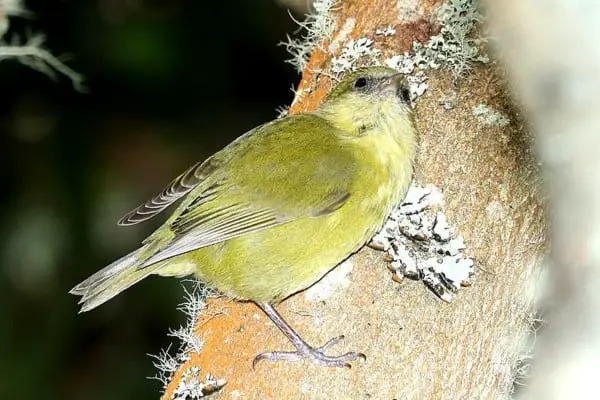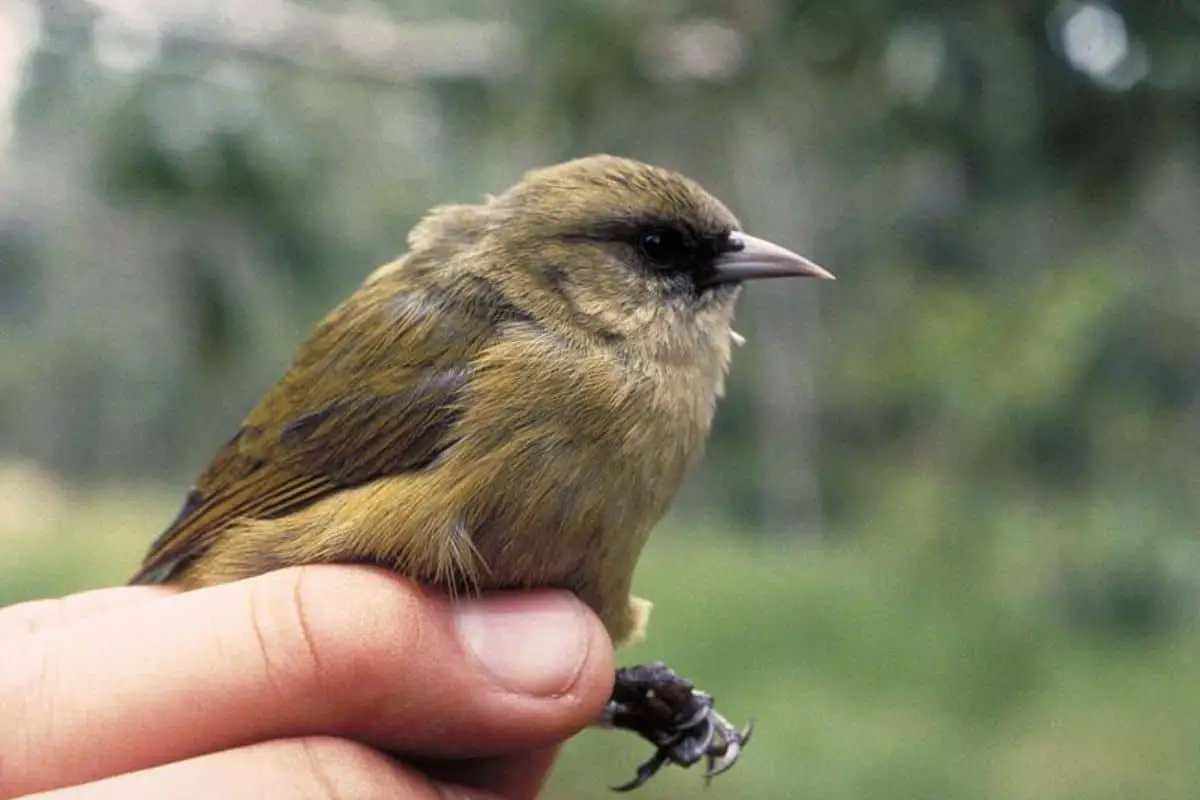Common Name: Hawaiʻi Creeper
Scientific Name: (Loxops mana)| Size | Diet | Range in Hawaii | Status in Hawaii |
|---|---|---|---|
| 4.7 in. - 5.9 in. | insects and nectar | island of Hawai'i (Big Island | Endangered |
The Hawaiʻi Creeper (Loxops mana), also known as the ʻAlawī, is a fascinating and unique bird species that is native to the Big Island of Hawaiʻi. With its distinctive green and yellow plumage and playful behavior, this honeycreeper is a beloved sight in its natural habitat.
However, the species is currently listed as endangered due to habitat loss and other threats. In this article, we’ll explore the fascinating world of the Hawaiʻi Creeper (ʻAlawī), its role in Hawaii’s ecosystem, and the efforts being made to protect and preserve this incredible bird.
Hawaiʻi Creeper
Appearance

The Hawai’i Creeper is a small bird species with a distinct appearance. It measures approximately 4.7 to 5.9 inches (12 to 15 centimeters) in length.
This species has a slender body and a slightly curved bill that is adapted for probing into tree bark and flowers in search of insects and nectar. Its plumage is predominantly green, providing excellent camouflage within the forest habitat. The head, back, and wings are primarily olive-green, while the underparts are a lighter shade of green.
The Hawai’i Creeper exhibits sexual dimorphism, with males and females displaying slight differences in plumage. Males typically have brighter and more vibrant plumage, with a yellowish wash on the throat and upper breast. Females, on the other hand, have a more subdued coloration, lacking the yellow wash.
Diet
The diet of the Hawai’i Creeper primarily consists of insects and nectar. As an insectivorous bird, it feeds on a variety of small arthropods, including beetles, spiders, caterpillars, and other invertebrates found in the forest environment.
To obtain its food, the Hawai’i Creeper uses its specialized bill to probe into tree bark and crevices, searching for hidden insects. It may also glean insects from leaves and branches, utilizing its agility and slender body to navigate through the foliage.
In addition to insects, the Hawai’i Creeper supplements its diet with nectar. It visits flowers to extract nectar using its brush-tipped tongue. While feeding on nectar, the bird inadvertently assists in pollination, transferring pollen from one flower to another.
Nesting
The nesting behavior of the Hawai’i Creeper involves the construction of a small cup-shaped nest made primarily of plant materials. These nests are typically located in the upper branches of tall trees within the forest habitat.
The female Hawai’i Creeper takes the primary responsibility for nest construction, although the male may assist in gathering nesting materials. The nest is intricately woven using fine plant fibers, moss, and lichens, creating a sturdy structure that provides protection and support for the eggs and later the hatchlings.
The breeding season of the Hawai’i Creeper occurs during the spring and summer months. The female lays a clutch of two to three eggs, which are incubated by both parents for a period of about 14 to 16 days. The parents take turns incubating the eggs, ensuring they are kept warm and protected.
Once the eggs hatch, both parents participate in feeding and caring for the nestlings. They bring small insects and other arthropods to the nest to provide nourishment for the growing chicks. The nestlings remain in the nest for a few weeks, gradually developing their feathers and acquiring the strength and skills necessary for independent survival.
Behavior
The Hawai’i Creeper displays a range of behaviors that are characteristic of its species. When foraging for food, it utilizes its slender bill to probe into tree bark and flowers, skillfully extracting insects and nectar. With its strong claws and agile body, it moves vertically along tree trunks and branches with ease.
The bird communicates through various vocalizations, emitting soft chirps and trills during territorial disputes and to communicate with mates and offspring. During the breeding season, male Hawai’i Creepers engage in courtship displays, fluffing their feathers, flicking their wings, and vocalizing to attract females.
They are territorial, vigorously defending their feeding and nesting areas against intruders. While typically solitary, they may form loose flocks or associations with other species during foraging. When it comes to nesting, both parents participate in incubating the eggs and caring for the nestlings, providing food and protection until the young birds are ready to fledge.
Habitat

The Hawai’i Creeper is a bird species that inhabits the diverse forested habitats of the Hawaiian Islands. It is primarily found in montane forests characterized by a mix of native tree species, such as koa (Acacia koa), ‘ohi’a lehua (Metrosideros polymorpha), and ko’oko’olau (Bidens spp.). These forests are often located at higher elevations, typically above 600 meters, although the species has been observed at a range of elevations.
The bird prefers mature forests with a dense canopy, as well as understory vegetation and shrubs that provide cover and foraging opportunities. Within its habitat, the Hawai’i Creeper tends to occupy areas with abundant insect populations and flowering plants, as these are important food sources for the species.
Due to its specialization in foraging along tree trunks and branches, the Hawai’i Creeper is well-adapted to the vertical structure of the forest environment. It navigates effortlessly through the trees, utilizing its slender body and strong claws to move along tree trunks and access food resources.
Range
Currently, the Hawai’i Creeper is known to inhabit specific locations on the island of Hawai’i. It is found between 700 and 2,200 meters elevation, with a concentration primarily above 1,100 meters. However, there have been declines in population densities, especially below 1,000 meters and on the western slopes of mountains such as Mauna Loa and Mt Hualalai.
Conservation Status
The Hawai’i Creeper is currently classified as an endangered species. The population of this bird has significantly declined over the years due to various factors, including habitat loss, disease, logging, grazing, and development. The destruction and fragmentation of its native forest habitat have had a severe impact on its numbers and range.
Recognizing the importance of conserving this unique bird species, the United States Fish and Wildlife Service (USFWS) listed the Hawai’i Creeper as endangered in 1975. Subsequently, the State of Hawaii also designated it as endangered in 1982. These listings highlight the urgent need for conservation efforts to protect and restore the population and habitats of the Hawai’i Creeper.
Interesting Facts
1. Vertical foraging
The bird is known for its unique foraging behavior, as it specializes in climbing tree trunks and probing into bark crevices to find insects. Its slender body and strong claws enable it to move vertically through the forest canopy.
2. Unique tongue adaptation
Unlike most other honeycreepers, the Hawai’i Creeper has a tubular tongue, which it uses to extract nectar from flowers. It is the only Hawaiian honeycreeper known to have evolved a tubular tongue.
3. Social behavior
While generally a solitary bird, the Hawai’i Creeper may form loose flocks or associations with other species during foraging. These mixed-species foraging groups can provide safety in numbers and opportunities for shared information about food sources.
4. Unique plumage
he bird has predominantly green plumage, which serves as excellent camouflage within the forest environment. Males exhibit brighter colors and may have a yellowish wash on the throat and upper breast.
Frequently Asked Questions
1. Why is the Hawai’i Creeper endangered?
The Hawai’i Creeper is listed as endangered due to several factors, including habitat loss, disease, logging, grazing, and development. These threats have caused a significant decline in its population.
2. What is the lifespan of the Hawai’i Creeper?
The exact lifespan of the Hawai’i Creeper in the wild is not well-documented. However, similar honeycreeper species are known to have average lifespans of 5 to 10 years.
3. What are the major threats to the Hawai’i Creeper’s habitat?
The major threats to the habitat of the Hawai’i Creeper include habitat degradation and loss due to human activities such as urbanization, agriculture, and invasive species colonization. Additionally, climate change and the associated changes in temperature, rainfall patterns, and vegetation distribution pose long-term risks.




